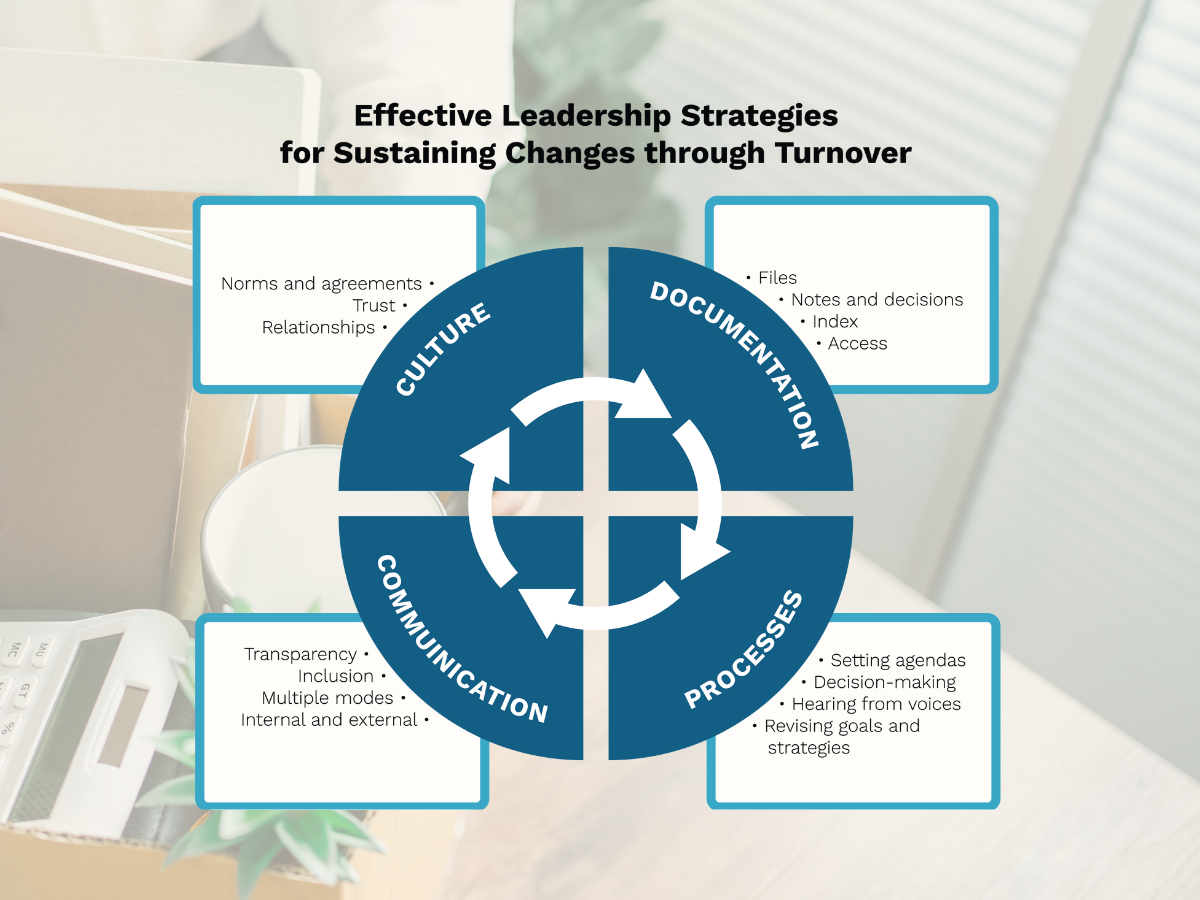
On Oct. 6, MTEP 2.0 had a NIC-Cast focused on helping networked improvement communities (NICs) handle personnel turnover. You can now view the recording of the whole group portions of the NIC-Cast. You can also view a short recording of a poster about turnover [1] that was presented at the 2025 Transforming Institutions conference (scroll down to the Research Poster section).
Turnover can happen to change agents, NIC members, or K-12 or higher education administrators. It can take the form of people leaving (retiring, leaving an institution); joining (being hired or brought into the efforts); or roles in the NIC changing when people’s responsibilities change. We want to help NICs maintain or expand efforts through turnover, not have turnover result in a NIC fizzling or losing momentum.
In planning for turnover, we encourage NIC leaders to consider the interrelated areas of communication, processes, logistics and documentation and culture. (See image.)
In this article, we recap the NIC-Cast and synthesize notes taken during breakout group discussions. First, we encourage you to plan for anticipated or hypothetical turnover related to different roles of NIC members and administrators your NIC works with. You will want to ask:
- Who is leaving or joining?
- What are their roles/responsibilities?
- What knowledge, skills, connections and power do we need to replace?
- How will we learn about new people’s knowledge skills, connections and power?
- How do we on-board new members?
To prepare for handling logistics and documentation related to turnover, consider the following:
- Who is responsible for turnover logistics (updating folder sharing, IRB, website, calendar invitations, etc.)?
- How are we intentionally documenting our change efforts?
- What documentation do or could we have to help on-board new people?
Change agents also suggested two types of "about us" documents. One is akin to a team report, listing members, institutions, aims/goals and summaries of past work. Another option is to create a document or slide deck where each person adds a section or slide to introduce themselves with photos; people can add other information such as communication preferences (emails, documents, internal messaging).
To plan for sustainable processes in the face of turnover, you may want to consider:
- How do we authentically incorporate ideas from new folks, without losing momentum?
- How should we redistribute responsibilities and roles?
- How do we capture "institutional knowledge" of departing folks?
- How are we intentionally creating inclusive processes?
Change agents suggested figuring out a system to take notes on the "institutional knowledge" of NIC members and administrators, to make sure NICs are not always having to start over. One change agent suggested keeping NIC leader and NIC member journals to document information; another suggested some type of apprenticeship or shadowing model when turnover is anticipated and there can be some overlap in participation. Another change agent suggested making an informational video about the work the NIC is doing.
To plan for sustainable communication in the face of turnover, you may want to consider:
- How do we intentionally communicate with various NIC members and administrators?
- How do we communicate our goals, strategies and impacts both internally and externally?
- What modes of communication do we use?
To communicate externally, change agents agreed that we have to get past the feeling that we are bragging. However, reframing efforts as external communication and targeting messages at specific audiences can help people see the value in our change efforts. Presenting NIC information and progress at regional or state math teacher or AMTE-affiliate conferences can be valuable external communication. Some change agents have hosted (or are planning to host) viewings of the documentary Counted Out to invite mathematicians and even community members into discussions.
Finally, but perhaps most importantly, NIC culture needs to be part of intentionally planning to handle turnover. Questions change agents might ask include:
- How are we intentionally establishing a positive culture?
- What will we do to build trust with new members?
- How do we gain support from new administrators?
- How are we ensuring multiple connections of people across departments or institutions?
- How do we set, update and communicate group norms?
We strongly suggest each NIC create a written turnover plan that attends to culture, logistics and documentation, processes and communication, with consideration for different responsibilities of people who may leave, join, or change roles (including NIC leaders, NIC members and administrators). NICs might treat a turnover plan as a series of PDSA cycles, taking some time across the next few months to work on each piece of their plan. It will be harder to test this plan without ongoing turnover, but NICs can consider sharing their documentation with other NICs or with colleagues who are not part of the NICs to ask for feedback.
A subset of the Nebraska team has a new track 1 IUSE project called Sustaining Undergraduate STEM Transformation And Improvement Networks through Change Agent Turnover (SUSTAIN CAT), which will be developing and piloting a change agent toolkit to better understand how STEM educational change networks sustain themselves and their efforts when people leave or shift roles. In Spring 2026, the SUSTAIN CAT project will be extending MTEP 2.0 NICs an opportunity to pilot the CAT Toolkit.
References
1. Smith, W., & Pomykal Franz, D. (2025, June 9-11). Sustaining change efforts through turnover: Exploring and reflecting on effective leadership strategies [Poster presentation]. Transforming Institutions Conference, St. Louis, MO, United States.